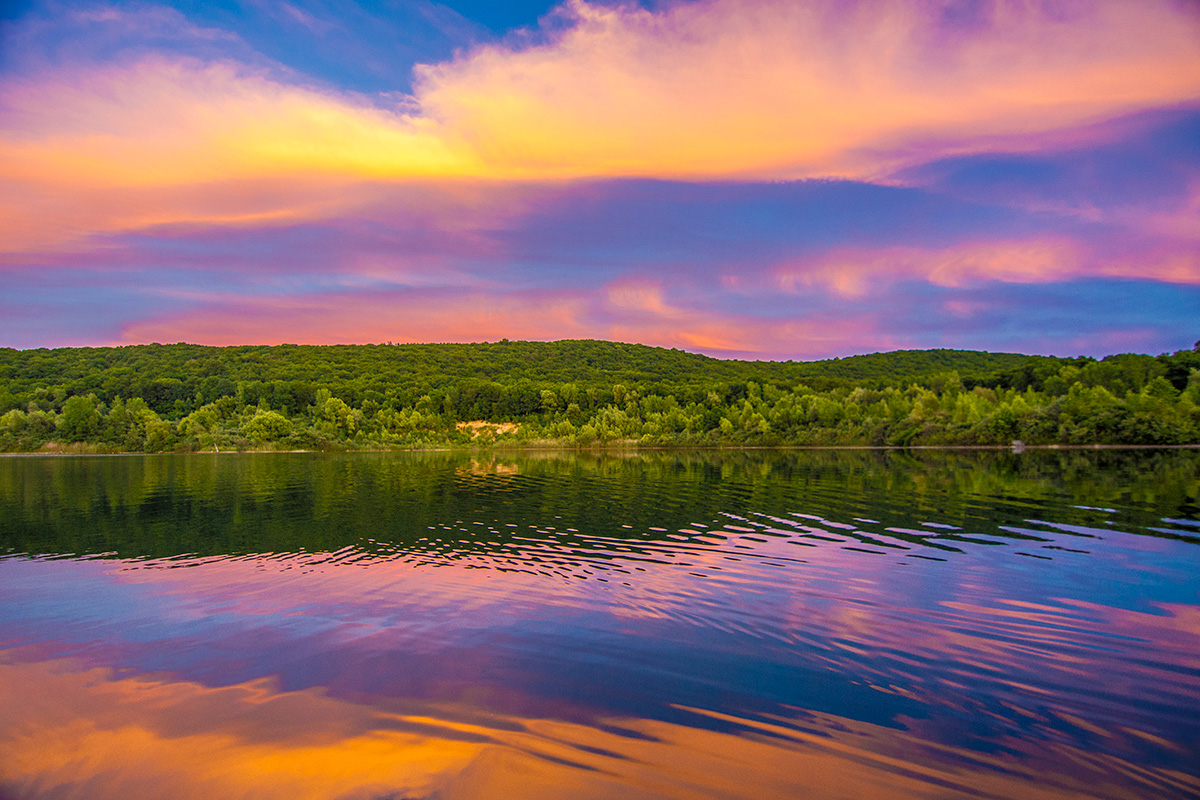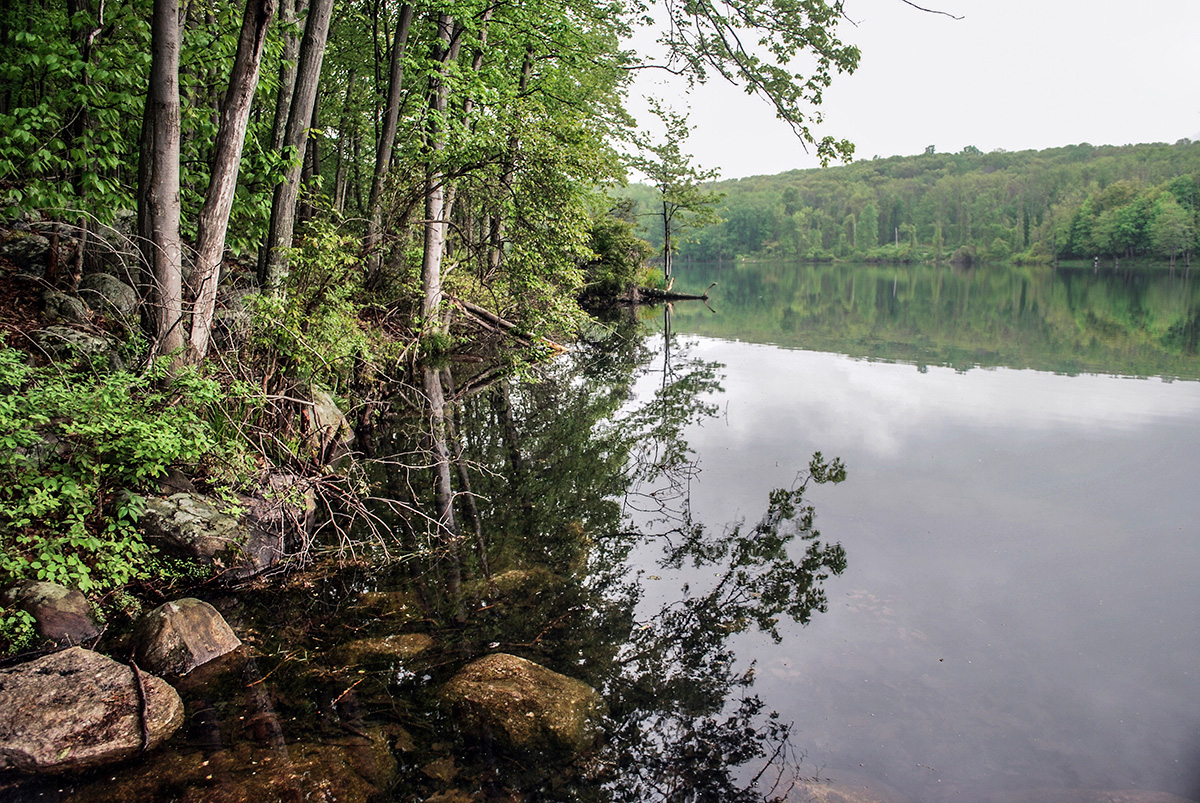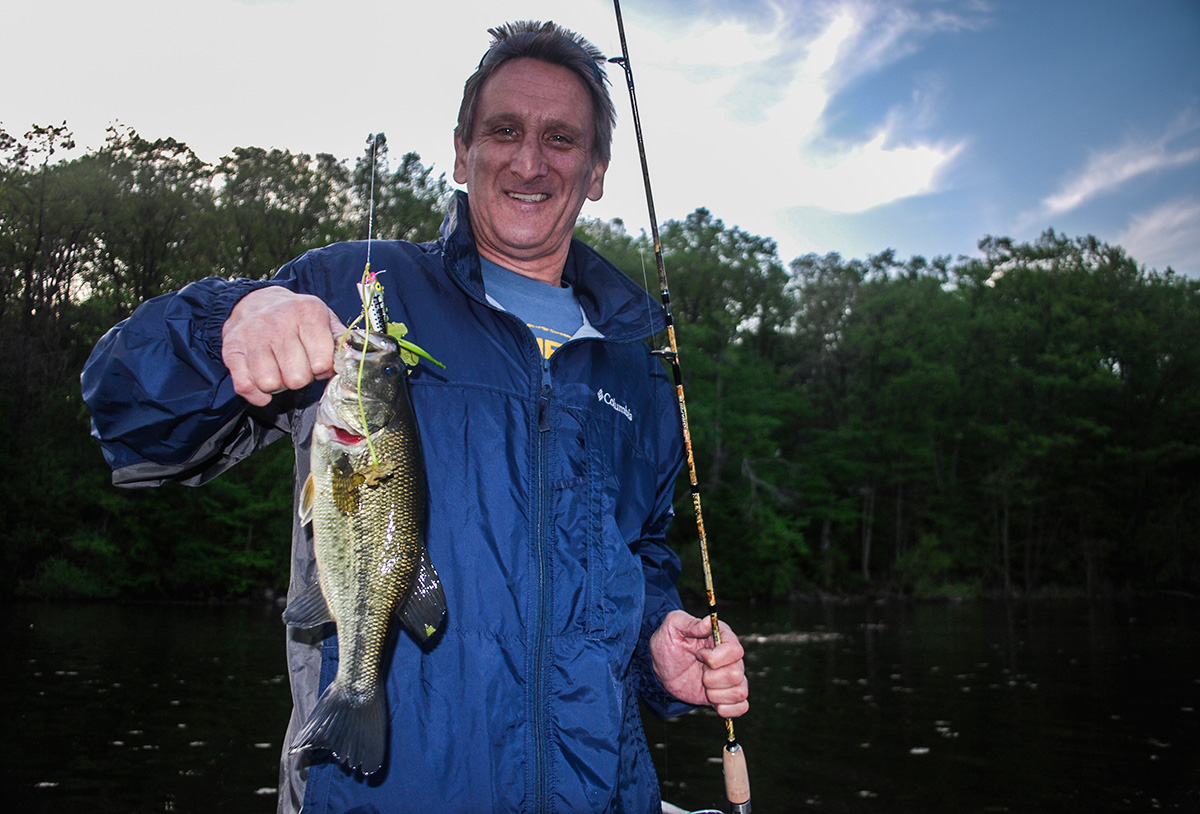
Counties statewide offer big bass for anglers looking for relaxed summer setting and pace.
Many years ago, I barely twitched a surface plug no larger than a cricket—a Blabbermouth by Gudebrod no longer manufactured. Early morning enclosed senses like a blanket, nothing was yet fully awake. I was 15 and getting acquainted with surface lures, particularly curious about the appearance and uses of every plug I owned.
An older guy I fished with often praised the Blabbermouth, so it felt special because of my association with someone more experienced at its use. I took ownership of my fishing, the social side and the secretive, even though I was focused, I sometimes wasn’t fully present to each cast.
The hit came less than half-committed, but I glimpsed the head and knew when setting the hook I would feel a lot of bass. I weighed a Mercer County lunker at 5 pounds, fully 20 inches long with wide girth.
Distractions of globalized New Jersey today may stress anglers, but necessities remain absolute regardless of social vagaries. Fishing pressure may mean bass get picky, so there’s need to offer your quarry what they won’t deny; yet deep down, people and bass don’t change. The lakes, reservoirs, and ponds of New Jersey do change, however. I’ve seen bass fishing improve in some cases, decline in others.
Bring a Plug to Life
Poppers like the Rebel Pop-R, tailspinners in the Hedden Torpedo class, and walkers a la the Zara Spook, not to mention soft-bodied weedless plastics, all offer opportunity to extend the life in your mind, arms and hands to the lure you’ve cast. Meanwhile chuggers like the Arbogast Crazy Crawler and Jitterbug, as well as buzzbaits, typically involve varying from the standard retrieve. For example, I cast chuggers into the wind and ride them on the back of chop. The trick to the use of any topwater is really just a mystery created in the present.
Habit is basic to fishing, but force of habit destroys unique opportunity; and when you get involved in thinking about how to retrieve a plug, you may miss what the moment suggests. Irregular cadence, for example, is a double-edged sword; you can easily make a plug behave erratically by mindless jerks; but the other side is anticipating what a bass wants. If you have any success at surface fishing, you already know to some degree. If not, summer in New Jersey is the time to learn.
Besides topwaters, I mostly fish plastic worms in New Jersey waters for summer largemouths. Both approaches expect bass with high metabolic rates to conserve calories by taking life slowly; they want easy meals, and if you can make a lure seem juicy, that’s incentive for a take. There’s a slight exception to this rule. Sometimes a big exception.
When light is changing—early morning, late evening, when a front develops—bass sight is advantaged over fish forage. As light shifts, largemouth tend to hug bottom, looking upward to spot silhouettes of baitfish. Forage fish inhabit relative shallows and come out of hiding in low light. Bass do too. Topwaters are just the ticket to bass looking for something alive outlined above. Some fronts involve barometric drops correlating with sudden increases of feeding activity. Bass let go of inhibitions and throw a food fest. This can happen any time of day, and I presume at night, but a fever pitch of summer activity is rare.
Count on sunrise or sunset for good action, with 10 to 20 minutes of heightened feeding activity often ensuing. A summer largemouth of at least 6 pounds once leapt clear out of the water to come down on my son’s Torpedo during a Lake Musconetcong evening, but didn’t get hooked. Predicting when is unlikely, but near sunset and sunrise, action noticeably spikes.
Otherwise, think of fish scales. They reflect luminescence, but brilliant summer afternoons make largemouths lazy. Light reflected from a Mepp’s Aglia Long spinner blade may further inhibit bass response. But a plug on top poking subtly against indeterminate light—light in the process of changing—often provokes interest. Guesswork can give you an edge. Move a plug at the wrong instant, and a bass might sink away. Rarely can you see a bass at your offering, but if you pay attention, experience can tell you when it’s best to twitch.

Finding Fish Comes First
Conditions of light are basic to bass behavior, but from an angling perspective, finding your quarry is even more important. Most of us know about weeds, sticks and timber, docks, shallow flats of stained water, protective shoreline edges, even rocks and boulders as habitat for numbers of bass that feed on a smorgasbord of summer forage in relatively shallow water. But how to zero-in on a bass with a topwater? This should be an interesting question, because it poses a single bass as target.
Ultimately, the individual approach best succeeds one by one. Unless a bunch of bass go on that rare gorge, or a few crowd a tight corner of a pond, keeping the possibility of one bass in mind makes you a focused hunter rather than an agricultural seed-sprayer. You won’t always catch the sense of just where a bass might be, but with enough experience, you get this ability. Go back to original roots; to your fish sense if you will. Connect with this ancient and truly authentic intelligence, and you will pleasantly surprise yourself. Because instead of becoming a crude cave man, you will realize a high level of cortical activity.
Each bass in Monksville Reservoir, Prospertown Lake or Menantico Sand Wash Ponds is in a specific place, possibly tending towards another spot. The more experience gained on the water by freeing distractions and fully being there, the more this ability to pinpoint a single bass develops. When you succeed, you will feel strongly compelled to repeat like performances, but don’t count on success each time out. Remember that the mind apprehends a lot more than it can consciously know, so never sell yourself short of time on the water. If you normally fish brine from a 27-foot center console, running electric power on Manasquan Reservoir will do the other habit good. Anyone who crosses boundaries learns everything is interrelated.

Garden State Variety
As for choosing rods, reels, line, brands and plug types, it all comes down to personal preference. Almost 20 years ago, I bought a 5-1/2-foot medium power, fast action St. Croix, an all-round rod of very high quality that I use for all sorts of fishing. For plugging, the fast tip gives me better control than slow action, the short length is accurate, and it’s light enough to respond tightly as I work a plug. Once I dropped my St. Croix aside for a 7-foot rod to cast a heavier Rebel Pop-R far into a corner of Mount Hope Pond. First cast scored big with a bass weighing close to 5 pounds, with sunrise almost an hour away. Toting two rods appropriate to different plug weights and casting distance can make sense, even when shore fishing.
Developing emotional attachments to tackle is as essential as feelings for Jersey home waters. If you take a disinterested look at any lure, it may seem absurd, no matter how accurate the paint job; just like a kid’s toy. But fish with that attitude and you won’t go far.
The second sight of values bestows upon our topwater collections—each plug individually—the meaning of our pursuit. Fish with purpose instead of out-of-the-box. The lures you choose will have life in them before you leave the dock. That’s confidence, sure.
But more than confidence, each plug you own specifies experience.
| BEST BETS: NEW JERSEY NINE |
|---|
|
Lake Hopatcong: New Jersey’s largest lake straddling Morris and Sussex counties features rocky, gravelly or sandy-bottomed shallows, but lots of weeds. In many spots, rocks forbid weed growth creating pockets and edges. Weedlines outlie numerous boathouses and docks holding bass. Coves and weedbeds offer opportunity helping make Hopatcong a premier New Jersey bass destination. Unlimited horsepower. Round Valley Reservoir: This 2,300-acre reservoir in Hunterdon County was sampled in 2016 by the DF&W. Largemouths over 15 inches are very uncommon, but some bass grow very large, as evidenced by an 8.85-pound largemouth that was netted. Despite low water level, the back of Ranger Cove gets weedy. Cast plugs right against the bank at night. Ten horsepower is allowed. Lake Wawayanda: At 255 acres, this Sussex County glacial lake permits the use of electric outboards, and you can mark 90-foot depths on your fishfinder, but concentrate on weeds for largemouth. Don’t overlook weeds adjacent to very deep water, but a big surprise may await in one of many overlooked nooks. Lake Assunpink: An impoundment of the Assunpink Creek headwaters in Monmouth County, 225 acres offer electric-powered topwater opportunities for unusually large bass, but remember trophy regulation waters such as this are only better by statistical margins, unless you connect. A well-defined creek channel gets a lot of pressure, but for good reason, so relatively shallow edges are places to try. Some edges feature sunken Christmas trees implanted by the Rising Sun Bassmasters. Maximum depth is 14 feet. Stone Tavern Lake: Fifty-two acres, 24 feet deep at most, this lesser-known lake precedes Assunpink Lake along the same watershed. Three long, relatively narrow coves feature shorelines dropping off to explore in detail. The Bucketmouth Brigade Bassin’ Team sunk Christmas trees on the shallow ends of some drop-offs. Carnegie Lake: Stony Brook and the Millstone River dammed in Mercer County, this 237-acre lake averages about 4 feet deep and is heavily silted without cover. Lily pads grow close to shore and provide habitat, but fish the area of the D & R Canal and Millstone River Aqueduct and the mouth of Stony Brook 20 oxygenated feet deep at lake’s head. Both spots are accessible by shore; electric outboards are permitted. Manasquan Reservoir: Situated in Howell Township, Monmouth County – near the coast – this 770-acre structural dream offers nearby resident saltwater anglers a convenient shot at something different. Flooded timber is the prominent structure. Combine wood and drop-off edges, but find bass back in the thick, too. Monmouth County Park System offers electric-powered boats for rent and also a public ramp. Union Lake: At 898 acres, South Jersey’s largest lake located in Cumberland County features high fertility, lots of vegetation, some deadfalls, islands, and manmade additions such as Christmas trees and tire reefs. Deepest water near the dam is 27 feet, mean depth of 9 feet. Gizzard shad and herring forage present – thanks to a fish ladder – largemouth grow big. Up to 10 horsepower allowed. Sunset Lake: This 88-acre lake also in Cumberland County was stocked with largemouths by the DF&W in 2015, having filled after getting drained in 2011 for repairs. By past accounts, the future here is promising. |



